 Technology peripherals
Technology peripherals
 AI
AI
 The largest reconstruction in history of 25km²! NeRF-XL: Really effective use of multi-card joint training!
The largest reconstruction in history of 25km²! NeRF-XL: Really effective use of multi-card joint training!
The largest reconstruction in history of 25km²! NeRF-XL: Really effective use of multi-card joint training!
Original title: NeRF-XL: Scaling NeRFs with Multiple GPUs
Paper link: https://research.nvidia.com/labs/toronto-ai/nerfxl/assets/nerfxl.pdf
Project link: https://research.nvidia.com/labs/toronto-ai/nerfxl/
Author affiliation: NVIDIA University of California, Berkeley

Thesis idea:
This paper proposes NeRF-XL, a principle method for interoperating between multiple graphics processors (GPUs) Allocates Neural Ray Fields (NeRFs), thereby enabling the training and rendering of NeRFs with arbitrarily large capacities. This paper first reviews several existing GPU methods that decompose large scenes into multiple independently trained NeRFs [9, 15, 17] and identifies several fundamental issues with these methods that are problematic when using additional Computing resources (GPUs) for training hinder the improvement of reconstruction quality. NeRF-XL solves these problems and allows NeRFs with any number of parameters to be trained and rendered by simply using more hardware. The core of our approach is a novel distributed training and rendering formulation, which is mathematically equivalent to the classic single-GPU case and minimizes communication between GPUs. By unlocking NeRFs with an arbitrarily large number of parameters, our method is the first to reveal the GPU scaling laws of NeRFs, showing improved reconstruction quality as the number of parameters increases, and as more GPUs are used The speed increases with the increase. This paper demonstrates the effectiveness of NeRF-XL on a variety of datasets, including MatrixCity [5], which contains approximately 258K images and covers an urban area of 25 square kilometers.
Paper design:
Recent advances in new perspective synthesis have greatly improved our ability to capture neural radiation fields (NeRFs), making the process more Easy to approach. These advances allow us to reconstruct larger scenes and finer details within them. Whether by increasing the spatial scale (e.g., capturing kilometers of a cityscape) or increasing the level of detail (e.g., scanning blades of grass in a field), broadening the scope of a captured scene involves incorporating a greater amount of information into NeRF to Achieve accurate reconstruction. Therefore, for information-rich scenes, the number of trainable parameters required for reconstruction may exceed the memory capacity of a single GPU.
This paper proposes NeRF-XL, a principled algorithm for efficient distribution of neural radial scenes (NeRFs) across multiple GPUs. The method in this article makes it possible to capture scenes with high information content (including scenes with large-scale and high-detail features) by simply increasing hardware resources. The core of NeRF-XL is to allocate NeRF parameters among a set of disjoint spatial regions and train them jointly across GPUs. Unlike traditional distributed training processes that synchronize gradients in backward propagation, our method only needs to synchronize information in forward propagation. Furthermore, by carefully rendering the equations and associated loss terms in a distributed setting, we significantly reduce the data transfer required between GPUs. This novel rewrite improves training and rendering efficiency. The flexibility and scalability of this method enable this paper to efficiently optimize multiple GPUs and use multiple GPUs for efficient performance optimization.
Our work contrasts with recent approaches that have adopted GPU algorithms to model large-scale scenes by training a set of independent stereoscopic NeRFs [9, 15, 17]. Although these methods do not require communication between GPUs, each NeRF needs to model the entire space, including background areas. This results in increased redundancy in model capacity as the number of GPUs increases. Furthermore, these methods require blending of NeRFs when rendering, which degrades visual quality and introduces artifacts in overlapping regions. Therefore, unlike NeRF-XL, these methods use more model parameters in training (equivalent to more GPUs) and fail to achieve improvements in visual quality.
This paper demonstrates the effectiveness of our approach through a diverse set of capture cases, including street scans, drone flyovers, and object-centric videos. The cases range from small scenes (10 square meters) to entire cities (25 square kilometers). Our experiments show that as we allocate more computing resources to the optimization process, NeRF-XL begins to achieve improved visual quality (measured by PSNR) and rendering speed. Therefore, NeRF-XL makes it possible to train NeRF with arbitrary capacity on scenes of any spatial scale and detail.
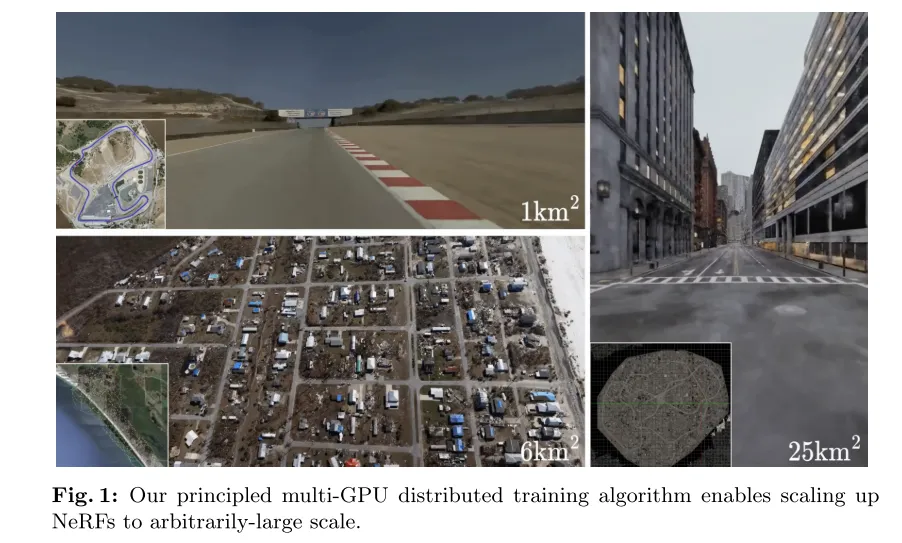
#Figure 1: This article’s principle-based multi-GPU distributed training algorithm can expand NeRFs to any large scale.

Figure 2: Independent training and multi-GPU joint training. Training multiple NeRFs [9, 15, 18] independently requires each NeRF to model both the focal region and its surrounding environment, which leads to redundancy in model capacity. In contrast, our joint training method uses non-overlapping NeRFs and therefore does not have any redundancy.

Figure 3: Independent training requires blending when new perspectives are synthesized. Whether blending is performed in 2D [9, 15] or 3D [18], blur will be introduced in the rendering.

Figure 4: Independent training leads to different camera optimizations. In NeRF, camera optimization can be achieved by transforming the inaccurate camera itself or all other cameras as well as the underlying 3D scene. Therefore, training multiple NeRFs independently along with camera optimization may lead to inconsistencies in camera corrections and scene geometry, which brings more difficulties to hybrid rendering.
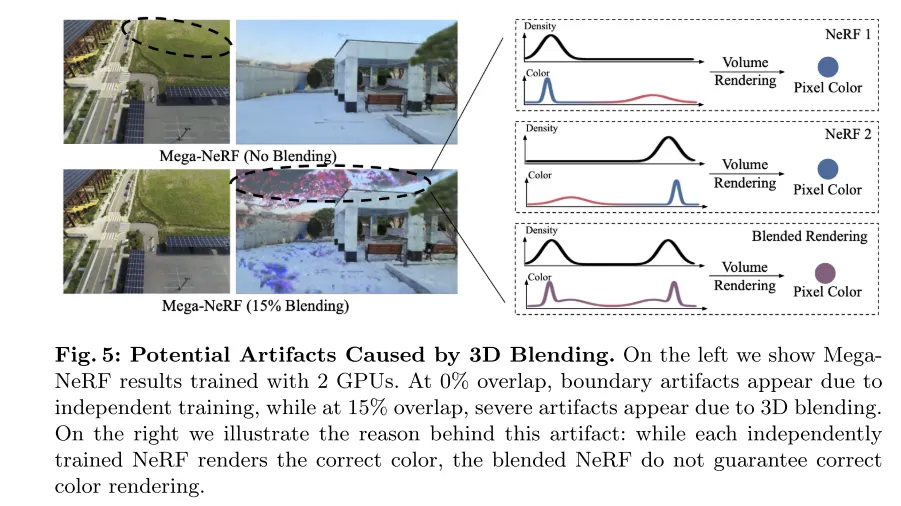
Figure 5: Visual artifacts that may be caused by 3D blending. The image on the left shows the results of MegaNeRF trained using 2 GPUs. At 0% overlap, artifacts appear at the boundaries due to independent training, while at 15% overlap, severe artifacts appear due to 3D blending. The image on the right illustrates the cause of this artifact: while each independently trained NeRF renders the correct color, the blended NeRF does not guarantee correct color rendering.
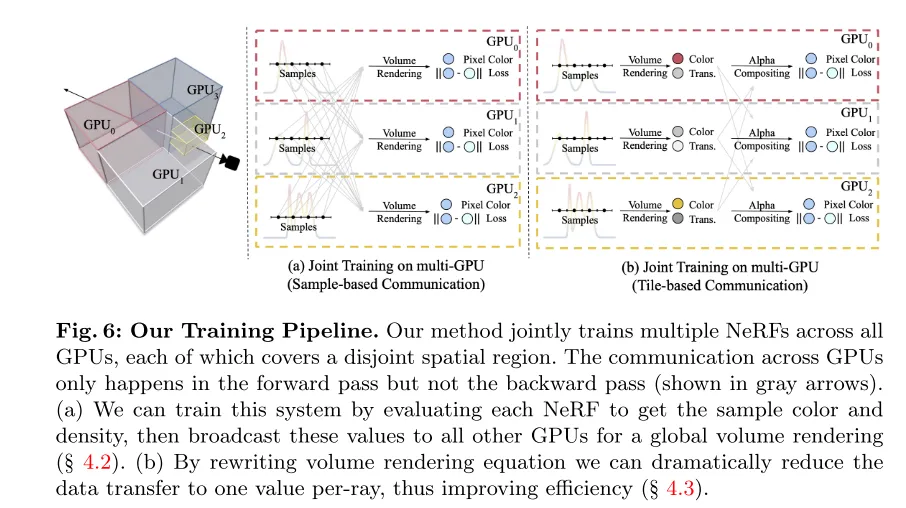
Figure 6: The training process of this article. Our method jointly trains multiple NeRFs on all GPUs, with each NeRF covering a disjoint spatial region. Communication between GPUs only occurs in forward pass and not in backward pass (as indicated by the gray arrow). (a) This paper can be implemented by evaluating each NeRF to obtain sample color and density, and then broadcasting these values to all other GPUs for global volume rendering (see Section 4.2). (b) By rewriting the volume rendering equation, this paper can significantly reduce the amount of data transmission to one value per ray, thus improving efficiency (see Section 4.3).
Experimental results:

Figure 7: Qualitative comparison. Compared with previous work, our method effectively leverages multi-GPU configurations and improves performance on all types of data.
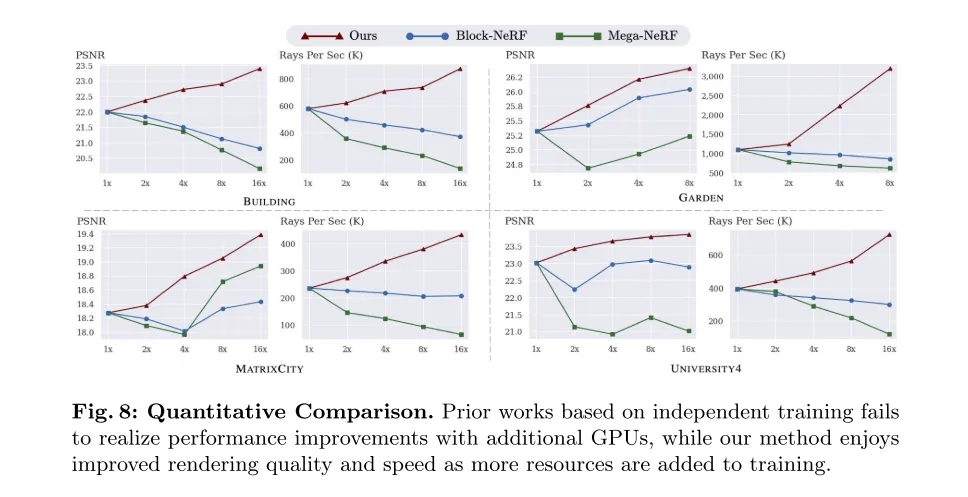
Figure 8: Quantitative comparison. Previous work based on independent training failed to achieve performance improvements with the addition of additional GPUs, while our method enjoys improvements in rendering quality and speed as training resources increase.
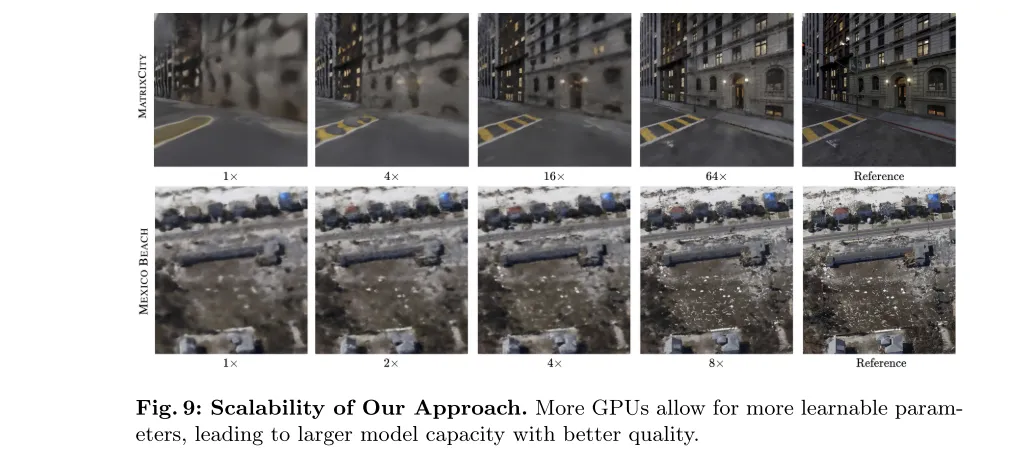
Figure 9: Scalability of this article’s method. More GPUs allow for more learnable parameters, which results in greater model capacity and better quality.

Figure 10: More rendering results on the large scale capture. This paper tests the robustness of our method on a larger captured data set using more GPUs. Please see the web page of this article for a video tour of these data.
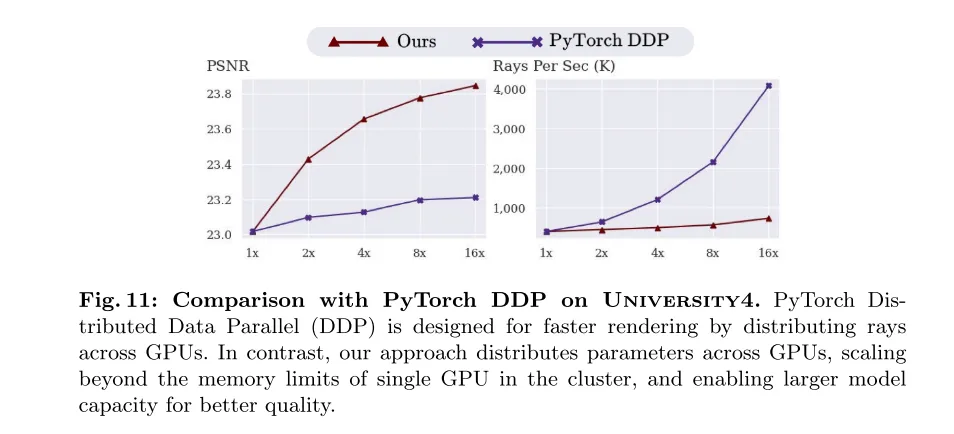
Figure 11: Comparison with PyTorch DDP on University4 dataset. PyTorch Distributed Data Parallel (DDP) is designed to speed up rendering by distributing light across the GPU. In contrast, our method distributes parameters across GPUs, breaking through the memory limitations of a single GPU in the cluster and being able to expand model capacity for better quality.
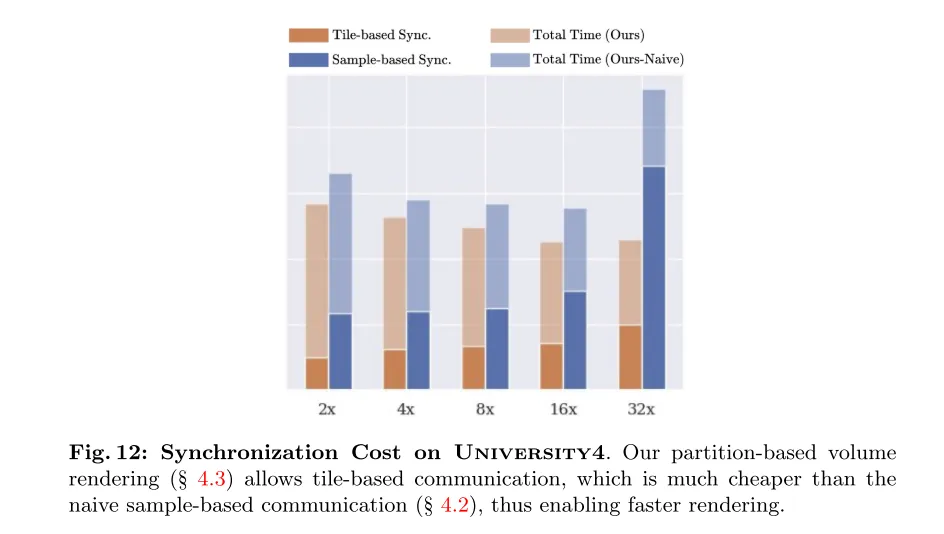
Figure 12: Synchronization cost on University4. Our partition-based volume rendering (see Section 4.3) allows tile-based communication, which is much less expensive than the original sample-based communication (see Section 4.2) and therefore enables faster rendering.
Summary:
In summary, this paper revisits existing methods of decomposing large-scale scenes into independently trained NeRFs (Neural Radiation Fields) and finds that This presents a significant problem that hinders the efficient utilization of additional computing resources (GPUs), which contradicts the core goal of leveraging multi-GPU setups to improve large-scale NeRF performance. Therefore, this paper introduces NeRF-XL, a principled algorithm capable of efficiently leveraging multi-GPU setups and enhancing NeRF performance at any scale by jointly training multiple non-overlapping NeRFs. Importantly, our method does not rely on any heuristic rules and follows NeRF’s scaling laws in a multi-GPU setting and is applicable to various types of data.
Quote:
@misc{li2024nerfxl,title={NeRF-XL: Scaling NeRFs with Multiple GPUs}, author={Ruilong Li and Sanja Fidler and Angjoo Kanazawa and Francis Williams},year={2024},eprint={2404.16221},archivePrefix={arXiv},primaryClass={cs.CV}}The above is the detailed content of The largest reconstruction in history of 25km²! NeRF-XL: Really effective use of multi-card joint training!. For more information, please follow other related articles on the PHP Chinese website!

Hot AI Tools

Undresser.AI Undress
AI-powered app for creating realistic nude photos

AI Clothes Remover
Online AI tool for removing clothes from photos.

Undress AI Tool
Undress images for free

Clothoff.io
AI clothes remover

AI Hentai Generator
Generate AI Hentai for free.

Hot Article

Hot Tools

Notepad++7.3.1
Easy-to-use and free code editor

SublimeText3 Chinese version
Chinese version, very easy to use

Zend Studio 13.0.1
Powerful PHP integrated development environment

Dreamweaver CS6
Visual web development tools

SublimeText3 Mac version
God-level code editing software (SublimeText3)

Hot Topics
 Open source! Beyond ZoeDepth! DepthFM: Fast and accurate monocular depth estimation!
Apr 03, 2024 pm 12:04 PM
Open source! Beyond ZoeDepth! DepthFM: Fast and accurate monocular depth estimation!
Apr 03, 2024 pm 12:04 PM
0.What does this article do? We propose DepthFM: a versatile and fast state-of-the-art generative monocular depth estimation model. In addition to traditional depth estimation tasks, DepthFM also demonstrates state-of-the-art capabilities in downstream tasks such as depth inpainting. DepthFM is efficient and can synthesize depth maps within a few inference steps. Let’s read about this work together ~ 1. Paper information title: DepthFM: FastMonocularDepthEstimationwithFlowMatching Author: MingGui, JohannesS.Fischer, UlrichPrestel, PingchuanMa, Dmytr
 The world's most powerful open source MoE model is here, with Chinese capabilities comparable to GPT-4, and the price is only nearly one percent of GPT-4-Turbo
May 07, 2024 pm 04:13 PM
The world's most powerful open source MoE model is here, with Chinese capabilities comparable to GPT-4, and the price is only nearly one percent of GPT-4-Turbo
May 07, 2024 pm 04:13 PM
Imagine an artificial intelligence model that not only has the ability to surpass traditional computing, but also achieves more efficient performance at a lower cost. This is not science fiction, DeepSeek-V2[1], the world’s most powerful open source MoE model is here. DeepSeek-V2 is a powerful mixture of experts (MoE) language model with the characteristics of economical training and efficient inference. It consists of 236B parameters, 21B of which are used to activate each marker. Compared with DeepSeek67B, DeepSeek-V2 has stronger performance, while saving 42.5% of training costs, reducing KV cache by 93.3%, and increasing the maximum generation throughput to 5.76 times. DeepSeek is a company exploring general artificial intelligence
 Hello, electric Atlas! Boston Dynamics robot comes back to life, 180-degree weird moves scare Musk
Apr 18, 2024 pm 07:58 PM
Hello, electric Atlas! Boston Dynamics robot comes back to life, 180-degree weird moves scare Musk
Apr 18, 2024 pm 07:58 PM
Boston Dynamics Atlas officially enters the era of electric robots! Yesterday, the hydraulic Atlas just "tearfully" withdrew from the stage of history. Today, Boston Dynamics announced that the electric Atlas is on the job. It seems that in the field of commercial humanoid robots, Boston Dynamics is determined to compete with Tesla. After the new video was released, it had already been viewed by more than one million people in just ten hours. The old people leave and new roles appear. This is a historical necessity. There is no doubt that this year is the explosive year of humanoid robots. Netizens commented: The advancement of robots has made this year's opening ceremony look like a human, and the degree of freedom is far greater than that of humans. But is this really not a horror movie? At the beginning of the video, Atlas is lying calmly on the ground, seemingly on his back. What follows is jaw-dropping
 KAN, which replaces MLP, has been extended to convolution by open source projects
Jun 01, 2024 pm 10:03 PM
KAN, which replaces MLP, has been extended to convolution by open source projects
Jun 01, 2024 pm 10:03 PM
Earlier this month, researchers from MIT and other institutions proposed a very promising alternative to MLP - KAN. KAN outperforms MLP in terms of accuracy and interpretability. And it can outperform MLP running with a larger number of parameters with a very small number of parameters. For example, the authors stated that they used KAN to reproduce DeepMind's results with a smaller network and a higher degree of automation. Specifically, DeepMind's MLP has about 300,000 parameters, while KAN only has about 200 parameters. KAN has a strong mathematical foundation like MLP. MLP is based on the universal approximation theorem, while KAN is based on the Kolmogorov-Arnold representation theorem. As shown in the figure below, KAN has
 AI subverts mathematical research! Fields Medal winner and Chinese-American mathematician led 11 top-ranked papers | Liked by Terence Tao
Apr 09, 2024 am 11:52 AM
AI subverts mathematical research! Fields Medal winner and Chinese-American mathematician led 11 top-ranked papers | Liked by Terence Tao
Apr 09, 2024 am 11:52 AM
AI is indeed changing mathematics. Recently, Tao Zhexuan, who has been paying close attention to this issue, forwarded the latest issue of "Bulletin of the American Mathematical Society" (Bulletin of the American Mathematical Society). Focusing on the topic "Will machines change mathematics?", many mathematicians expressed their opinions. The whole process was full of sparks, hardcore and exciting. The author has a strong lineup, including Fields Medal winner Akshay Venkatesh, Chinese mathematician Zheng Lejun, NYU computer scientist Ernest Davis and many other well-known scholars in the industry. The world of AI has changed dramatically. You know, many of these articles were submitted a year ago.
 The vitality of super intelligence awakens! But with the arrival of self-updating AI, mothers no longer have to worry about data bottlenecks
Apr 29, 2024 pm 06:55 PM
The vitality of super intelligence awakens! But with the arrival of self-updating AI, mothers no longer have to worry about data bottlenecks
Apr 29, 2024 pm 06:55 PM
I cry to death. The world is madly building big models. The data on the Internet is not enough. It is not enough at all. The training model looks like "The Hunger Games", and AI researchers around the world are worrying about how to feed these data voracious eaters. This problem is particularly prominent in multi-modal tasks. At a time when nothing could be done, a start-up team from the Department of Renmin University of China used its own new model to become the first in China to make "model-generated data feed itself" a reality. Moreover, it is a two-pronged approach on the understanding side and the generation side. Both sides can generate high-quality, multi-modal new data and provide data feedback to the model itself. What is a model? Awaker 1.0, a large multi-modal model that just appeared on the Zhongguancun Forum. Who is the team? Sophon engine. Founded by Gao Yizhao, a doctoral student at Renmin University’s Hillhouse School of Artificial Intelligence.
 Kuaishou version of Sora 'Ke Ling' is open for testing: generates over 120s video, understands physics better, and can accurately model complex movements
Jun 11, 2024 am 09:51 AM
Kuaishou version of Sora 'Ke Ling' is open for testing: generates over 120s video, understands physics better, and can accurately model complex movements
Jun 11, 2024 am 09:51 AM
What? Is Zootopia brought into reality by domestic AI? Exposed together with the video is a new large-scale domestic video generation model called "Keling". Sora uses a similar technical route and combines a number of self-developed technological innovations to produce videos that not only have large and reasonable movements, but also simulate the characteristics of the physical world and have strong conceptual combination capabilities and imagination. According to the data, Keling supports the generation of ultra-long videos of up to 2 minutes at 30fps, with resolutions up to 1080p, and supports multiple aspect ratios. Another important point is that Keling is not a demo or video result demonstration released by the laboratory, but a product-level application launched by Kuaishou, a leading player in the short video field. Moreover, the main focus is to be pragmatic, not to write blank checks, and to go online as soon as it is released. The large model of Ke Ling is already available in Kuaiying.
 The U.S. Air Force showcases its first AI fighter jet with high profile! The minister personally conducted the test drive without interfering during the whole process, and 100,000 lines of code were tested for 21 times.
May 07, 2024 pm 05:00 PM
The U.S. Air Force showcases its first AI fighter jet with high profile! The minister personally conducted the test drive without interfering during the whole process, and 100,000 lines of code were tested for 21 times.
May 07, 2024 pm 05:00 PM
Recently, the military circle has been overwhelmed by the news: US military fighter jets can now complete fully automatic air combat using AI. Yes, just recently, the US military’s AI fighter jet was made public for the first time and the mystery was unveiled. The full name of this fighter is the Variable Stability Simulator Test Aircraft (VISTA). It was personally flown by the Secretary of the US Air Force to simulate a one-on-one air battle. On May 2, U.S. Air Force Secretary Frank Kendall took off in an X-62AVISTA at Edwards Air Force Base. Note that during the one-hour flight, all flight actions were completed autonomously by AI! Kendall said - "For the past few decades, we have been thinking about the unlimited potential of autonomous air-to-air combat, but it has always seemed out of reach." However now,





